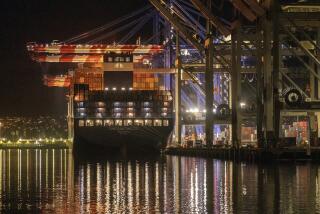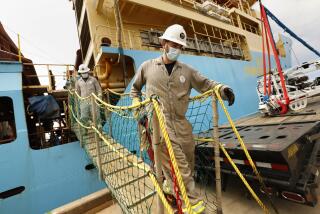For Many in San Diego, the Ocean Is a True Fountain of Life
- Share via
Mark C. Rogers, president, Seavac International Inc.:
“We do all types of underwater construction. Damn right we’re dependent on the ocean. Don’t know what we’d do without it. I mean, we do anything under water--pier rebuilding, pipeline installation, boat cleaning. We clean even U.S. ships and aircraft carriers, those big jobs you see in the harbor. We’ve done all this more than 30 years.
“We’ve also done dam repairs for the Mexican government, work in Colombia for Exxon, salvage jobs in Costa Rica . . . we’ve even worked with companies in Egypt and Greece. The ocean is the one thing that connects us all.
“What do I like about this work? It’s always something different, not the same old thing every day. I have anywhere up to 42 people working for me at any one time. You might find this funny, but we hold the world’s record (for working) in scuba gear with mixed gas, that is, a combination of helium and oxygen.
“We use scuba gear mainly for surveying. We do marine railway work, underwater welding and all kinds of stuff with explosives.
“One thing about this work is, it’s getting too high-tech. Kind of ticks me off, by the way. We’re getting away from the muscular type diver to the yuppie type diver. You don’t have a contract by handshake anymore. Everything now is dotting the i’s and crossing the t’s. The sports world isn’t the only place that kind of nonsense goes on.
“I mean, now you see different types of observation vehicles, TV vehicles, ultrasonic devices for checking the thicknesses of hulls--all for underwater repair work and diving. We just go right along with it. Anymore, you don’t change, you die.”
Anthony Ghio, senior vice president, Anthony’s seafood restaurants:
“To us, the ocean is survival for 650 people--our employees. We’ve been in business now 40 years. We have nine restaurants, four retail fish markets, a commissary and a wholesale fish market. The commissary prepares our sauces and vegetables. The wholesale fish market sells primarily to Anthony’s (retail) Fish Market. They prepare and portion all the seafood we buy at the dock. As you can see, it’s a big operation.
“Back in 1946, we were the only fish house in San Diego. Now there are lots of them. In fact, we’re inundated. Our competitors are all good restaurants, all featuring fresh seafood.
“That’s only one threat we face--the overbuilding of fish restaurants. Fish isn’t like cattle or chicken; there is only so much fish. Commercial fishermen are even having problems. Not as many young people are willing to (go through) hardships going out to catch fish. It is, after all, a tough life.”
Stephen (Scat) Scatolini, 32, surfboard maker, Canyon Surf Shop in Ocean Beach:
“I build the surfboards, I airbrush ‘em, and I’m also a salesman in the afternoons. I’ve done this sort of thing since 1972. The only reason I have this job is the ocean--I have to figure out ways to get out there as much as I can. I can surf at the drop of a hat. Or a surfboard.
“I have the freedom to pursue the surfing part and also scrape together a living. My boss and I have a good manana understanding--the work can wait until tomorrow, if it has to. I love having that freedom to embrace the ocean.
“I like surfing--and surfers, and helping them--as a challenge. It’s a challenge we’re in together. The ocean is the challenge. The biggest part of wave-riding is getting out of the water alive. There’s the thrill of being out there and enjoying that energy.”
Joe Medina, managing owner of a fleet of four tuna boats:
“I’ve been in the tuna business all my life. I’m 58 now. I was formerly a (tuna boat) captain. I did that for 35 years. I haven’t been out in five years--I’ve been here, behind a desk. But for a long time, the ocean--and fishing--were my life. And to some extent, they still are.
“I was born and raised in San Diego, went to Point Loma High School and San Diego City College. So I’ve always been fairly close to the water.
“What do I like about the ocean? I like fishing. There’s a lot of hassle about it now, too much at times. It isn’t as fun as it used to be. Things aren’t good, because the foreign imports have really hurt us. These are imports from Thailand, the Philippines and Taiwan.
“We fish only for tuna, and I must say the future doesn’t look good. It’ll never be the same as before, I suppose, ‘before’ being any time prior to 1981. Hell, we’ve closed all the canneries here. Everything is done offshore now.
“Despite the problems, I love going out fishing, catching a load of fish. It’s a very competitive business, and it’s fun to try to one-up somebody. You never know where you’re gonna find the fish; you just move around till you do. The travel is fun, though it’s hard on a woman if you’re married, and you just don’t see your kids grow up. Now I’m finally getting to enjoy my grandkids. I have five granddaughters, and I love getting to see them.”
Craig Leweck, salesman and sailmaker for Sobstad Sail Makers in San Diego:
“We make about 600 sails a year. The majority of our business is in the Star class. We do mostly one-design classes. We also enter a lot of races, mainly to show off the sails--the quality of the sails, which we are, of course, quite proud of.
“There’s not a lot of money in sailmaking, unless you’re dealing with the higher echelon of the really big boats. We do mainly the small dinghies, with the biggest boat being the Star, which is roughly 22 feet. The Snipe class, the next biggest, is around 15 feet. You need to do a big volume of sails to make it worth your while.
“The owner of our company, Mark Reynolds, recently won the Star class in the Goodwill Games in Moscow. We’re all quite proud of that. He beat out a Russian. A lot of our involvement is getting around and showing off the product. I’d say that Mark does it well.”
More to Read
Inside the business of entertainment
The Wide Shot brings you news, analysis and insights on everything from streaming wars to production — and what it all means for the future.
You may occasionally receive promotional content from the Los Angeles Times.










